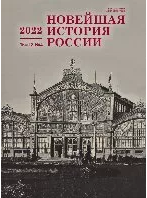Руководящие кадры блокадного Ленинграда в номенклатуре ЦК ВКП(б)
The Cadres of Besieged Leningrad on the Nomenclature Lists of the Central Committee of the ACP(b)
Author(s): Kirill Anatolyevich BoldovskiySubject(s): Governance, Political history, Government/Political systems, WW II and following years (1940 - 1949), History of Communism, Fascism, Nazism and WW II
Published by: Издательство Исторического факультета СПбГУ
Keywords: siege; Leningrad; Stalinism; nomenklatura; “Leningrad affaire”; control system; USSR;
Summary/Abstract: The research is based on briefing papers and other reporting documents prepared during 1943– 1944 by the Cadres department of the Leningrad City Committee of the ACP(b) for the Cadres Department of the Central Committee of the Party. It contains information on the senior leaders of besieged Leningrad, who were on the nomenclature lists of the Central Committee of the All-Union Communist Party of Bolsheviks. These lists included heads of organizations and enterprises that were considered the most important for the country. Briefing papers and reports contain information about the personal composition of managers, their education, age, previous jobs. Based on the analysis of these documents, the article concludes that during the Great Patriotic War, the cadres of Leningrad leaders consisted entirely of local officials. During the period of 1941–1944 less than half of the posts included in the nomenclature of the Central Committee for Leningrad were occupied by workers who were sent from other regions. Most of the leaders of the party and Soviet apparatus held their positions from the pre-war period throughout the entire period of the Siege. Cadre appointments were approved by heads of the Leningrad city committee, while the second secretary of the city committee A.A.Kuznetsov played the main part in this process. This policy led to the formation of a stable group of “Siege officials”, which remained in leadership positions in Leningrad until the start of purges in 1949–1950. Most of the Siege leaders belonged to the same age group (30–40 years old), about half of them had a higher, most often engineering, education. The article also discusses some typical cases of dismissal of executives from their positions. The author shows that during the Siege, such punishments were used by the local party leaders, and not by the initiative of the central authorities.
Journal: Новейшая история России
- Issue Year: 12/2022
- Issue No: 41
- Page Range: 840-852
- Page Count: 13
- Language: Russian

